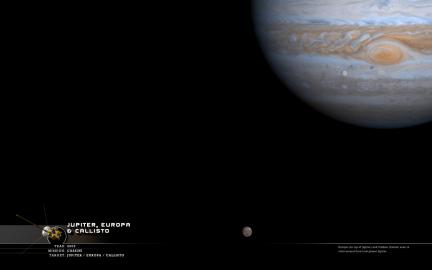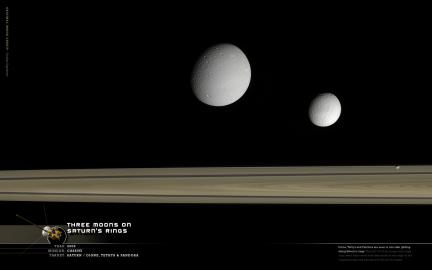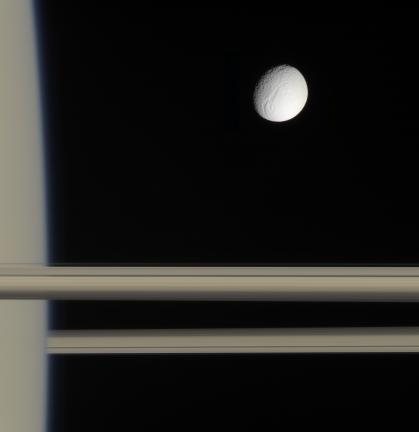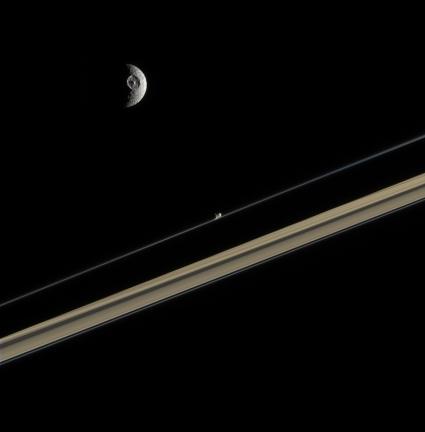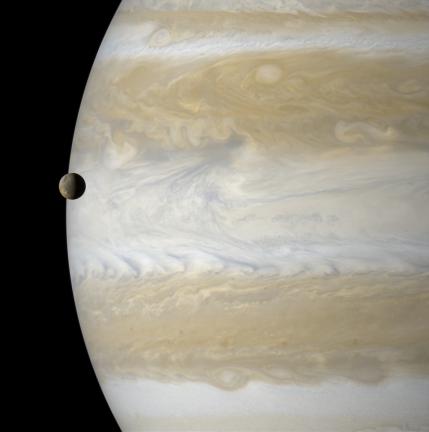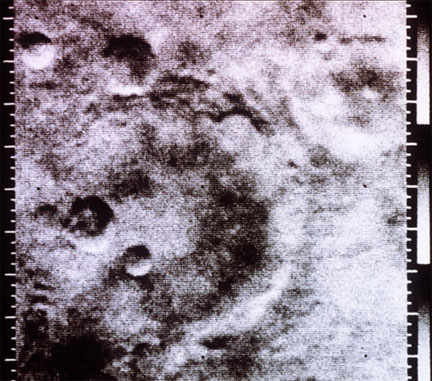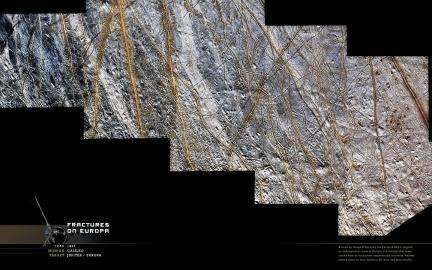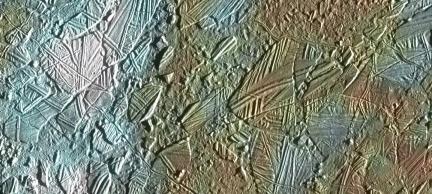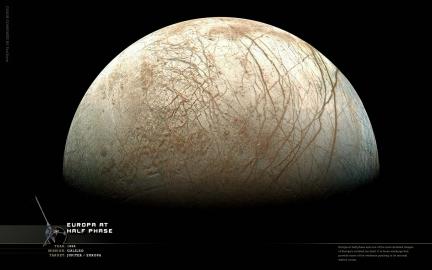Image Processors on Flickr: Gordan Ugarkovic
Gordan Ugarkovic has a great collection of reworked Cassini images on Flickr. I contacted Gordan about showing some of his images here on wanderingspace and he was ever so gracious. As many people Gordan is “somewhat underwhelmed by the frequency the Cassini Imaging Team releases color composites”, so it is up to excellent freelancers like him to compile this information from the data files which are made public by NASA. Problem is that these images rarely make it to the mass media and we are stuck with the dozen or so color images the NASA imaging teams decide to produce in a year.
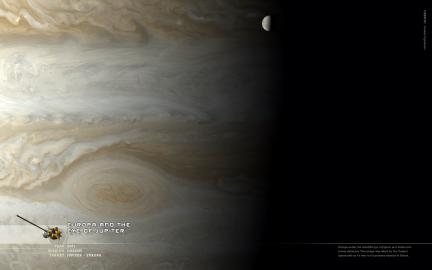
WALLPAPER NOTE: The left 1/3 of the “Three Moons” image was extended in Photoshop using data at the edges of the original image which was cropped to a square format. This “fake” imagery was only applied to that area of the rings and the rest of the image including the moons is actual.
Here are some other images from Gordan which are some of my favorites, but don’t trust my editing… go to the gallery and have a look yourself. For the sake of posterity I have added a permanent link to his gallery on the right side of this blog where you may note that there are already a few others linked. There were two additional ones but the sites have been taken down since I linked to them?! Hopefully the three left will stick around for a while and I will in time add more to the collection.
Tethys and Saturn’s Hazy Limb
Mimas and Prometheus on Rings
Io on Jupiters Edge
Life in the Hood: Europa
There are two schools of thought in the world on extra-terrestrial life coming from people who think seriously of such things. One is that the universe is teeming with life, yes… teeming. A good majority of folks these days think the universe is lousy with life forms. The second theory is that here on Earth life is a rare and possibly singular event. Either of these conclusions are quite a leap of faith for lack not only of evidence, but for opportunities to even discover any of the evidence needed to support either assertion. You see, the universe is spread out in a big way. It takes light from Earth a bit over 4 years to reach the nearest star to our sun Alpha Centauri, meaning that any astronomers at Centauri who might be peering out in our general direction see us as we were 4 years ago. So if it takes light that long to get to our nearest neighbor, you can imagine how long it would take our fastest, newest spacecraft to reach there. Using technologies not even mature enough to consider actually using, it still could take us 40+ years just to reach that nearest star… and that’s probably a liberal estimate. So apart from someone developing a hyper-warp drive which can surpass the speed of light (which they tell me is not only impossible but pose an awful lot of other difficult circumstances) or someone at SETI (Search for Extra Terrestrial Intelligence) picks up a faint and 25 year old signal coming from Vega (see the film Contact for reference), it would seem for the time being we are stuck having to search our own neighborhood.
About 30 years ago the outlook for life in our own solar system seemed bleak. The moon was as desolate as one could imagine and Mars when spied by Mariner 4 for the first time, up-close (see above), shocked and disappointed many with a surface that seemed more akin to our moon than with Earth. Gone were all the dreams of Martians directing canals to their great cities or even the hope of a Mars rat scurrying across the red dunes. In addition to this, the assumption was that the rest of the Solar System was hopelessly cold and unworthy of hosting even the smallest of microbes. The gas giants were surface-less hostile environs, most bodies lacked breathable air of any kind and Venus was so hot it would immediately fry anything hoping to eek out a living on its surface. Finally, after the Viking landers determined Mars to be lifeless in the 70’s (in what many now call a flawed experiment) most gave up hope and began seeing the Solar System as nothing more than a place filled with mostly cold lonely destinations offering mankind little more than an ultimate challenge of survival away from home. That was until Voyager sped by Jupiter and its moons a few years later and a small world most have never even heard of, named Europa, held out a glimmer of hope to those in the know.
After returning the first images of Europa’s surface riddled with ridges, cracks and what looked like considerable geological activity (see above wallpaper, actually taken by the Galileo not Voyager) many began to speculate these features must be the result of a vast underground ocean which causes stress on the outer “shell” and causes it to crack. This theory was propped up further when Galileo arrived at Jupiter in the 90’s. Much better resolution images revealed much greater detail including what appeared to be “icebergs” in a large region that from a distance appeared to look like shattered glass. You could easily see where one “berg” broke off from another and floated a distance away by some means (see below). This makes many as sure of the underground ocean on Europa as you can get without actually drilling down through the icy crust and plunking down into the wet core.
So if we have a moon made largely of water ice, who is being internally heated by tidal forces coming from Jupiter, we can almost assume that much of this body would be melted ice as you move down from the rock-hard frozen surface toward the warm center… and… one can assume that somewhere in between hot in the middle and cold on the surface, there may be a large zone of warm waters as cool and warm as that found on any Hawaiian beach. Meanwhile here on Earth, we have found that life survives nearly any hostile environment from 200 degree heat vents of acid water on the ocean floor to microbes found frozen in Antarctica. The theory goes, if life survives in hell on Earth why not a comparable heaven on Europa?
Wallpaper: Europa Portrait
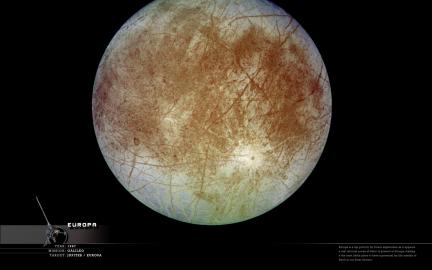 Europa has become a focal point of interest in our solar system. Subject to the same tidal forces that tear Io apart, Europa is less severely effected by this and here the stress takes the form of internal heating which keeps the moon from being frozen throughout. It has more-or-less been confirmed that below its icy crust lies an almost global ocean of 100% water. Considering that the center of the moon is quite warm and the icy shell is of course frozen rock-solid, somewhere in between must lie a zone with temperatures similar to that of earth deep within this watery underground ocean. As any marine biologist will tell you, the Earth's oceans are riddled with life. Even in places of extreme heat and cold, life still somehow has survived the ages and has adapted to such extreme environments. Leading to conjecture that no-matter the obstacles to life ever developing on the surface of such a place… the mere presence of earth-like conditions deep within Europa's dark underground water ocean may have been just enough for some if not many forms of life to evolve and survive to this day. There are many missions on the drawing board right now to find out more answers including a Europa orbiter, various landers and one truly aggressive mission that would involve melting through the crust and “injecting” a submersible probe into the watery core. For a new and improved portrait image of Europa see here.
Europa has become a focal point of interest in our solar system. Subject to the same tidal forces that tear Io apart, Europa is less severely effected by this and here the stress takes the form of internal heating which keeps the moon from being frozen throughout. It has more-or-less been confirmed that below its icy crust lies an almost global ocean of 100% water. Considering that the center of the moon is quite warm and the icy shell is of course frozen rock-solid, somewhere in between must lie a zone with temperatures similar to that of earth deep within this watery underground ocean. As any marine biologist will tell you, the Earth's oceans are riddled with life. Even in places of extreme heat and cold, life still somehow has survived the ages and has adapted to such extreme environments. Leading to conjecture that no-matter the obstacles to life ever developing on the surface of such a place… the mere presence of earth-like conditions deep within Europa's dark underground water ocean may have been just enough for some if not many forms of life to evolve and survive to this day. There are many missions on the drawing board right now to find out more answers including a Europa orbiter, various landers and one truly aggressive mission that would involve melting through the crust and “injecting” a submersible probe into the watery core. For a new and improved portrait image of Europa see here.
